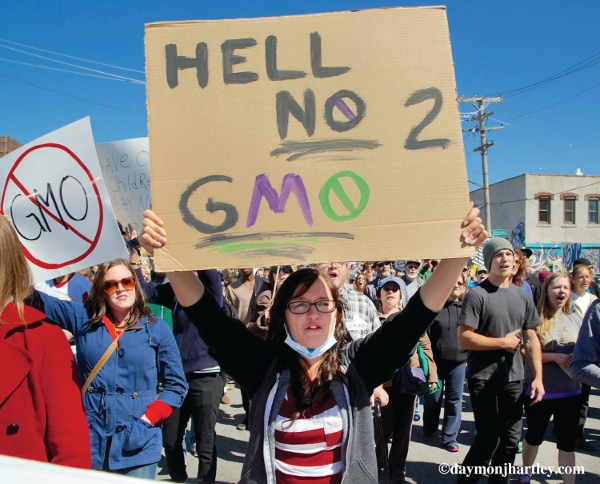
Photos/Daymonjhartley.com
SAN DIEGO, CA — On May 25 — Stop Monsanto Day — as worldwide actions were taking place, those of us in San Diego mounted one of our most successful actions since the First Occupy Assembly in support of Occupy Wall Street! Over 1000 people (some reports put it at between two and three thousand) assembled at the Main Fountain in Balboa Park! The action was sponsored by Food and Water Watch, with the support of all of the progressive groups in San Diego, including the Peace Resource Center, the San Diego Occupiers, the Green Party, PDA (Progressive Democrats of America), Earth First Movement, Labor Unions, United for Peace and Justice, and Occupelas (Women occupiers of San Diego Choir). Our new progressive Mayor sent a very supportive message!
After assembling in the park, listening to rousing speeches regarding the evils of GMO’s, Monsanto, and “Round-Up”, and some inspiring folk music, the group headed out for a six-mile march. Waving clever signs and chanting and drumming through the Hillcrest area and Little Italy and then returning via the Gaslamp area to the World Beat Center at Balboa Park, additional speakers engaged the demonstrators who were also entertained by more music including some very original songs by the Occupelas! The entire action was covered by all of our local TV stations. Of course—we were accompanied by many police officers on foot, motorcycles and paddy wagons—all “to protect us.”
Why protest Monsanto? It is the globe’s largest seed purveyor—and its dominant vendor of genetically modified traits. How dominant? Here’s National Public Radio on the company’s mastery over the US GMO market: “More than nine out of ten soybean seeds carry [Monsanto’s] Roundup Ready trait. It’s about the same for cotton and just a little lower for corn.” It also sells nearly $1 billion worth of herbicides every three months.
For all its clout, Monsanto is a relatively new player in the Big Ag game. As recently as the late 1970s Monsanto was known mostly as a chemical company; herbicides were a relatively small sideline, and genetically modified seeds were just the gleam in the eye of a few scientists in the R&D department. Its flagship chemical business had plunged into crisis. In 1976, Congress banned the highly toxic industrial coolant PCB. To make matters worse, the company was heavily invested in the toxic pesticide DDT (banned in 1972) and the infamous Vietnam War defoliant Agent Orange. How did Monsanto pivot from teetering, scandal-ridden chemical giant to mighty high-tech (though still quite controversial) agribiz firm?
A young consultant called Mitt Romney helped push the firm on its highly lucrative new path—selling off big chunks of its legacy chemical businesses and reinventing itself as ag-biotech firm. Of course, Monsanto 2.0 remained quite ruthless in its pursuit of profit. The metamorphosis merely meant trading one set of environmental controversies for another. Perhaps the agrichemical giant, too, will one day see its regulatory fortunes turn.

Great and well-written article. Thanks!